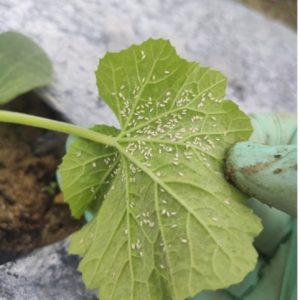
Alabama Extension reminds vegetable producers to be on the lookout for silverleaf whiteflies this fall.
The pests have become more common during the fall in the Southeast. An increase in activity has led to a reduction in yields for vegetable crops. These include yellow squash, zucchini, tomato, cucumber and snap beans.
Costly Impact
Whiteflies feed on the leaves but also transmit viruses that can be devastating. These include cucurbit leaf crumple virus, cucurbit yellow stunting disorder virus, squash vein yellowing virus, tomato yellow leaf curl virus and tomato chlorosis virus. Whitefly-transmitted viruses led to losses of more than $50 million in Georgia in 2016 and 2017. Whiteflies and their viruses are most prevalent in southeast Alabama, though the insect has been reported in central Alabama.
This year’s rainy summer conditions reduced the whitefly population throughout the state. However, dry conditions this fall could exacerbate whitefly infestations.
For conventional systems, several systemic insecticides belonging to Mode of Action (MOA) 4A (acetamiprid, imidacloprid), 4D (flupyradifurone), and 28 (chlorantraniliprole) are available for early season chemigation, soil, or foliar applications with labeled restrictions. Pyriproxifen (MOA 7C) is an insect growth regulator, and pyrifluquinazon (MOA 9B) is a feeding blocker with unique mode of action that can be incorporated in cases of resistant populations on large acres.
For organic producers, use temporary pest exclusion fabric like Protecknet and Super Lite Insect Barrier. They can reduce the early onset of whiteflies. But prolonged usage of these materials can lead to fruit setting and disease issues. Insecticidal soap, neem, and horticultural oil applications at frequent intervals can suppress early infestation. But they may not work in high insect populations that could lead to outbreaks. The use of biological control agents (predators and parasitoids) is highly recommended in closed environments but could be difficult to implement in open field conditions. Avoid using natural pyrethrin based materials to conserve natural enemies in crops.
The adult silverleaf whitefly is a small insect that is covered with a white and waxy layer. It uses a piercing-sucking mouthpart to feed on the phloem tissue which transports nutrients.









